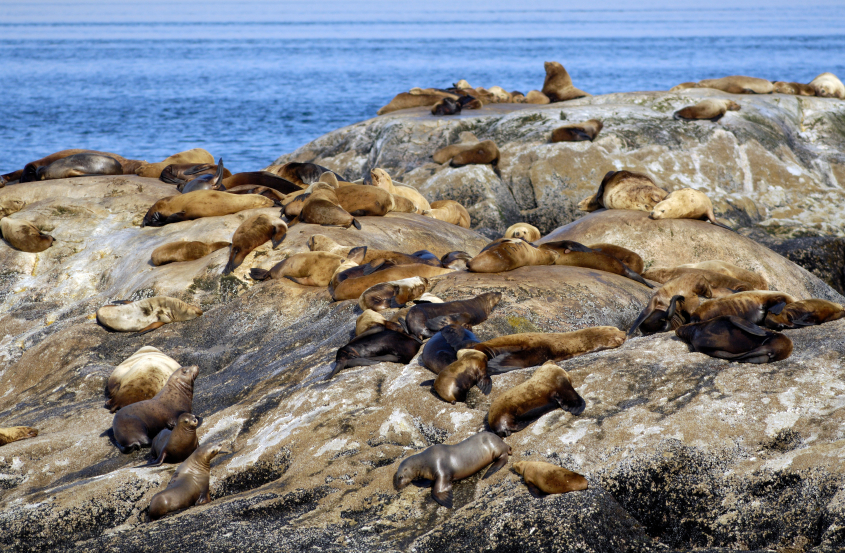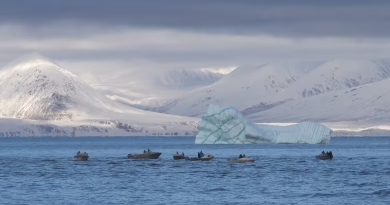Banned pollutants turn up in Alaska fur seals

A new study of contaminants known as persistent organic pollutants — various pesticides, preservatives and industrial chemicals — in the bodies of Alaska fur seals suggests that despite regulations and treaties banning or curbing their use, it might take a long time to eliminate them from the northern environment.
POPs have been accumulating for a long time in the northern latitudes, where they are carried on atmospheric and ocean currents from distant industrial and population centers.
The study, published online in the Archives of Environmental Contamination and Toxicology, analyzes blubber and liver samples from northern fur seals harvested over two decades by subsistence hunters from St. Paul, one of the Pribilof Islands in the northern Bering Sea.
Some of the contaminants have long been out of use. For those “legacy” contaminants — which include the notorious pesticide DDT, banned in the U.S. since 1972 — the study found that levels in the fur-seal samples had stabilized or decreased slightly over the sample period, 1987 to 2007.
Other contaminants that are either currently in use or have been curbed only recently — largely fire retardants — showed up in increasing levels in the fur-seal samples, the study found.
Legacy contaminants
In addition to DDT, other legacy contaminants include PCBs, a family of chemicals used in electrical equipment, household products and other goods, of which production was banned in the United States in 1979; chlordane, a pesticide used in the United States until 1988; andmirex, a pesticide used in the southeastern United States to battle fire ants before it was banned in 1978. Use of those and other legacy contaminants in the study were banned or curtailed internationally under the Stockholm Convention of 2001, though there are exceptions for use of DDT to combat malaria.
Analysis of the samples also found that levels of Vitamins A and E in the seals’ livers remained constant over the 20 years, contrary to a hypothesis that changing POP levels are linked to changing vitamin levels.
Vitamin levels
The study will help scientists watch for contaminant-load changes, including hoped-for decreases resulting from the international bans and restrictions imposed by the Stockholm Convention, said lead author Jessica Reiner, a research chemist at the National Institute of Standards and Technology, a federal science agency.
“This really was a study to get baseline information for chemical contamination and vitamins,” she said.
Thanks to an extensive bank of marine-mammal samples collected over the years, scientists at her agency and at the National Marine Fisheries Service will be able to monitor future trends, Reiner said.
Though levels of legacy POPs were stabilized or starting to decline in the seals, Reiner noted that some types — PCBs and DDT and its metabolites — dominated the contaminant load.
Breeding
Various PCB and DDT-related compounds made up about 70 percent of the contaminants found in the fur-seal samples, the study found. Levels varied widely among samples, but the median PCB load was 2,520 parts per billion and the median level for DDT-related compounds was 876 parts per billion, well above the loads for other contaminants measured, according to the study. In comparison, the median level for various types of polybrominated diphenyl ethers, the fire retardants known as PBDEs, was 24.5 per billion. PBDEs have been subject to relatively recent phase-outs under the Stockholm Convention and by several governments.
The territory of the northern fur seal ranges from the coast of Southern California to the waters off Japan, but about half the world’s population of the animals breed off Alaska’s Pribilof Islands, according to the National Marine Fisheries Service. Counts at the Pribilofs show that the population there has declined over several decades. The northern fur seal was classified in 1988 as depleted, in accordance with the Marine Mammal Protection Act.
Reiner said contaminant levels for the St. Paul fur seals were found to be in line with those of other far-north marine mammals.
Concerns for Far North
The research group has also been analyzing the same 1987-2007 fur-seal samples to determine trends for contamination by metals, including mercury, Reiner said. Results are expected to be published in the future.
Though POPs affect the whole world, there are special concerns about effects on the far-north environment and the northern people who rely on wild foods. Those concerns provided much of the impetus for the Stockholm Convention.
The convention highlights those concerns, acknowledging in its text “that the Arctic ecosystems and indigenous communities are particularly at risk because of the biomagnification of persistent organic pollutants and that contaminants of their traditional foods is a public health issue.” The convention started with bans on 12 “Dirty Dozen” chemical compounds; new POPs have been added to the list over the years.
The United States signed the Stockholm Convention in 2001 and is among the 179 governments that are parties to it. But the U.S. Senate has yet to ratify the convention, despite the urging of President George W. Bush and President Obama.
Related stories from around the North:
Canada: Fighting to protect bird habitat in North America’s boreal forest (SLIDESHOW), Eye on the Arctic
Finland: New measures to protect the Saimaa seal in Finland, Yle News
Iceland: Endangered whale meat shipped from Iceland via Halifax, The Canadian Press
Norway: Rapid growth in Svalbard walrus population, Barents Observer
Sweden: Sweden’s mountain hares changing fur color too early, Radio Sweden
United States: Chemical contaminants suspect in mystery of Alaska chickadee beak deformities, Alaska Dispatch News



